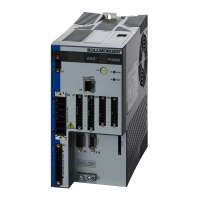AKD User Guide | 10 Configuring General Drive Settings
10.9.2.2 Software Enable Default
In addition, the Software Enable has two methods for enabling the AKD. This is controlled by DRV.E-
NDEFAULT. Default 0 leaves the software in the disabled state upon start-up. Default 1 enables the software
upon start-up.
10.9.3 Disable Modes
Use DRV.DISMODE to select the method for stopping the drive.
Mode 0: Immediately disable drive.
With this condition, the drive will immediately disable the power stages and the driven motor will either coast to a
stop or in the case of a vertical or overhung load axis, will fall abruptly. If a brake is present, the brake will be
applied according to MOTOR.TBRAKEAPP. Using Digital Input mode 13, you can achieve a controlled stop as
described in Mode 2.
Mode 1: Dynamic Brake to a stop.
In this situation, the drive will utilize the dynamic brake feature and stop motion quickly, then disable the power
stage. In most cases, the driven motor will stop quickly (pending the joules available and load circumstances). In
the case of an overhung or vertical load, the driven motor will attempt to stop, but then will continue to allow the
load to fall if no measures have been taken to secure the load.
Note for Modes 2 and 3, you can access the Controlled stop section to set the values of the controlled stop decel-
eration rate, the velocity threshold, and time in velocity threshold to deactivate the drive.
Mode 2: Controlled stop, then disable.
In this mode, acontrolledstopwill takeplacebasedonavariety of parameters that youset. First, the driven motor
will decelerateat acontrolled rate (CS.DEC)until oneof twothings happens. 1) The motorreaches thevelocity limit
set (CS.VTHRESH) foraperiodof time(CS.TO), or2)The driveemergency timeout is reached(DRV.DSTO).
Once eitherof thesecases is reached, thepowerstagewill bedisabled (and brake appliedif present)
Mode 3: Controlled stop, then dynamic brake.
Similar to Mode 2, the motor will decelerate at a controlled rate (CS.DEC) until CS.VTHRESH is reached for a
period of time (CS.TO). The drive will then dynamically brake and disable under the same conditions as
described in Mode 2.
The Disable Timeout Setting determines the amount of time the drive will follow the disable mode before it deac-
tivates the drive regardless of method chosen and alerts with an Emergency Timeout Fault.
All of these disable modes will operated based on what type of disable command is received. Any critical faults,
hardware disable, or STO disable will immediately turnoff the power stage, thus letting the driven motor coast of
free fall based on how the motor is secured.
10.9.4 Drive Status
The Drive Status area is displayed below the settings area and includes a graphical representation of drive
active status with different sets of inputs. If the input or output is enabled, then it is shown in green; if the input or
output is disabled, then it is shown in red. The inputs to the OR and & (AND) gates identify which conditions are
true (green) or false (red) and follow the normal logic for & (AND) and OR gates. This diagram is useful in finding
which input may be preventing the drive from being enabled. Click More to see the details of how the control stop
is executed displayed both logically and graphically.
104 Kollmorgen | December 2010

